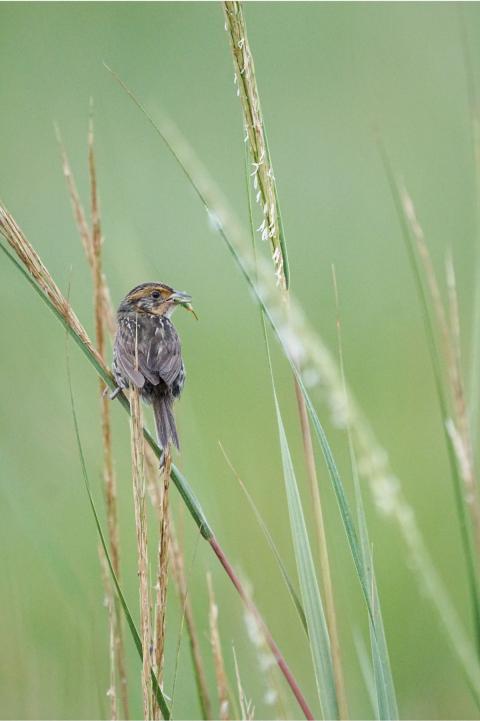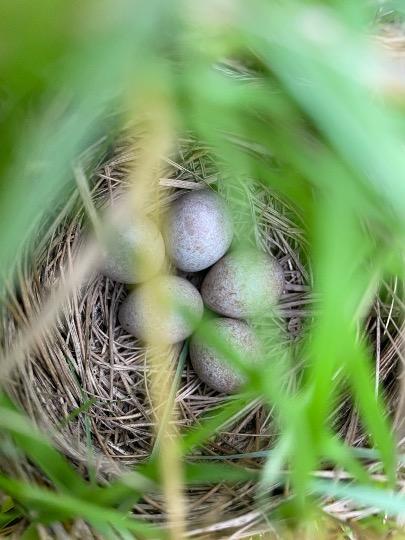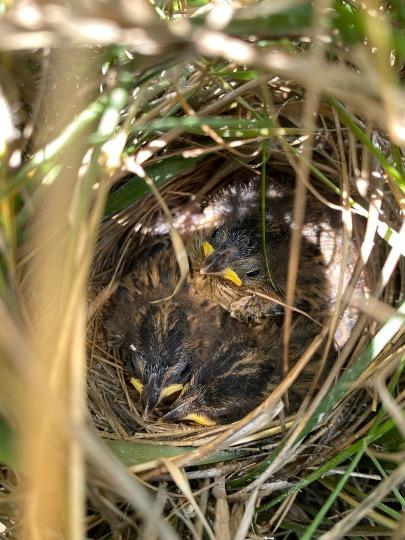Do you live near a salt marsh? Or maybe you’ve visited a NH beach and noticed the nearby marshes? If so, one of the coolest evolutionary stories may be playing out right under your nose. Keep reading to learn about the fascinating life history of a creature only found in salt marshes and the actions you can take to protect salt marshes in your community.
Observing a salt marsh provides a window into an amazing wildlife habitat. You are likely familiar with the Snowy Egrets, Ospreys, and Glossy Ibises that frequent our salt marshes. The species you may be less familiar with is the Saltmarsh Sparrow.
Saltmarsh Sparrows are secretive songbirds with unique behaviors. You can count yourself lucky if you’ve ever caught a glimpse of this small bird or heard its whisper song. While notoriously elusive, Saltmarsh Sparrows serve as important reminders of the impacts of climate change, which has led some to refer to them as the Canary in the Coastline.

A Saltmarsh Sparrow carries food to feed her chicks. Photo by Grace McCulloch.
While most birds nest in trees or shrubs, Saltmarsh Sparrows weave nests directly into the marsh grasses. Nesting in the salt marsh is a race against the tides. Nests are built in the high elevation parts of the marsh to prevent flooding from the daily high tides, but Saltmarsh Sparrows cannot escape the impacts of tides that flood the entire marsh platform. These high tides occur approximately once a month and correspond with the moon phases. During this period many nests flood, some eggs wash out of the nests, and any chicks that can’t keep their heads above the water drown.
With these challenges, how do any Saltmarsh Sparrow chicks make it to adulthood? Here is where the cool evolutionary history comes in. Over thousands of years Saltmarsh Sparrows have evolved a unique adaptation to outrace these flood tides. Females are adapted for rapid re-nesting after a flooding event in order to quickly get their chicks to the developmental stage (10 days old) where they can climb out of the nest and save themselves from the flood tides. A female Saltmarsh Sparrow has only 23-26 flood free days to go from laying 3-5 eggs in her nest to having her chicks ready to leave the nest. If the timing is right, all this can happen just before the next tide that floods the whole marsh (approximately 28 days from the proceeding one). There is little margin for error. (See: Salt Marsh Sparrow Nesting Cycle Diagram from the Cornell Lab of Ornithology)

A Saltmarsh Sparrow nest. It takes approximately 12 days from the time the last egg is laid to when the first chick hatches. Photo by Grace McCulloch.

A Saltmarsh Sparrow nest with ~ 10 day old chicks, just old enough to climb out of their nest and higher up in the grasses to escape the flood tides. Photo by Grace McCulloch.
This careful balance is threatened by sea-level rise as the window of opportunity for successful nesting begins to close with more frequent marsh flooding. A few centimeters of water level can be the difference between a successful nest and an unsuccessful one. Saltmarsh Sparrows illustrate the tangible impacts of accelerating rates of sea level rise. Researchers across the East Coast are exploring ways to conserve this species and protect our marshes. Without intervention this species could be extinct by the middle of this century and is already declining by 9% a year throughout its range.
While it can be overwhelming to think about the impacts of climate change on Saltmarsh Sparrows and coastal communities, there are some actions you can take to protect the salt marshes near your home or in your community.
- Appreciate [VL1] the beauty and ecological importance of our native marsh grasses, such Spartina patens and Juncus gerardii. These grasses provide the material Saltmarsh Sparrows need to build and hide their nests, and the vast root network of Spartina alterniflora stabilizes the soil and slows the impacts of sea level rise and erosion.
- Avoid trampling on salt marsh grasses during the growing season. Salt marsh grasses contain hollow tubes that bring oxygen down to their roots, but unfortunately their stems can be easily crushed by an unsuspecting human boot or a rambunctious dog.
- Keep dogs on a leash and limit all activity in the marsh, particularly during May to September when Saltmarsh Sparrows are nesting and are easily disturbed.
- Consider treating small stands of the invasive grass Phragmites to limit its spread. Saltmarsh Sparrows do not nest in Phragmites.
- Leave a wide, thick buffer of natural vegetation around a marsh (or any wetland) by limiting mowing and planting wildflowers, bushes or trees. A naturally vegetated buffer slows runoff and also gives the marsh room to change as the climate changes. For ideas on what to plant along a shoreline, consult this planting guide from NH DES.
If you own a substantial portion of salt marsh, we encourage you to reach out to Lynn Vaccaro at Great Bay National Estuarine Research Reserve to learn more about how to best steward your land.
If you own a portion of a salt marsh or you review projects that impact marshes, we encourage you to reach out to Lynn Vaccaro at Great Bay National Estuarine Research Reserve to learn more about land stewardship and tools such as the NH Salt Marsh Plan.
This article was written by Grace McCulloch and Lynn Vaccaro at Great Bay National Estuarine Research Reserve, where Grace is a Research Fellow supported by the Margaret A. Davidson Fellowship and Lynn is the Coastal Training Program Coordinator. Grace is a master’s student at the University of New Hampshire studying Saltmarsh Sparrow Habitat in Dr. Adrienne Kovach’s lab.


